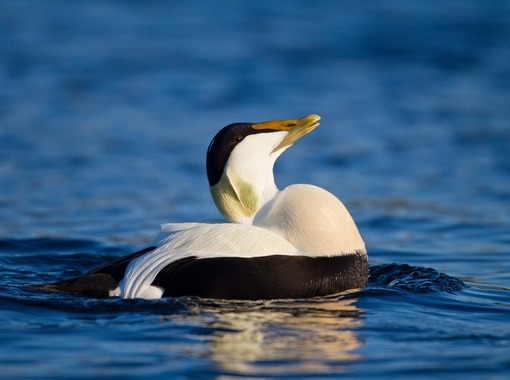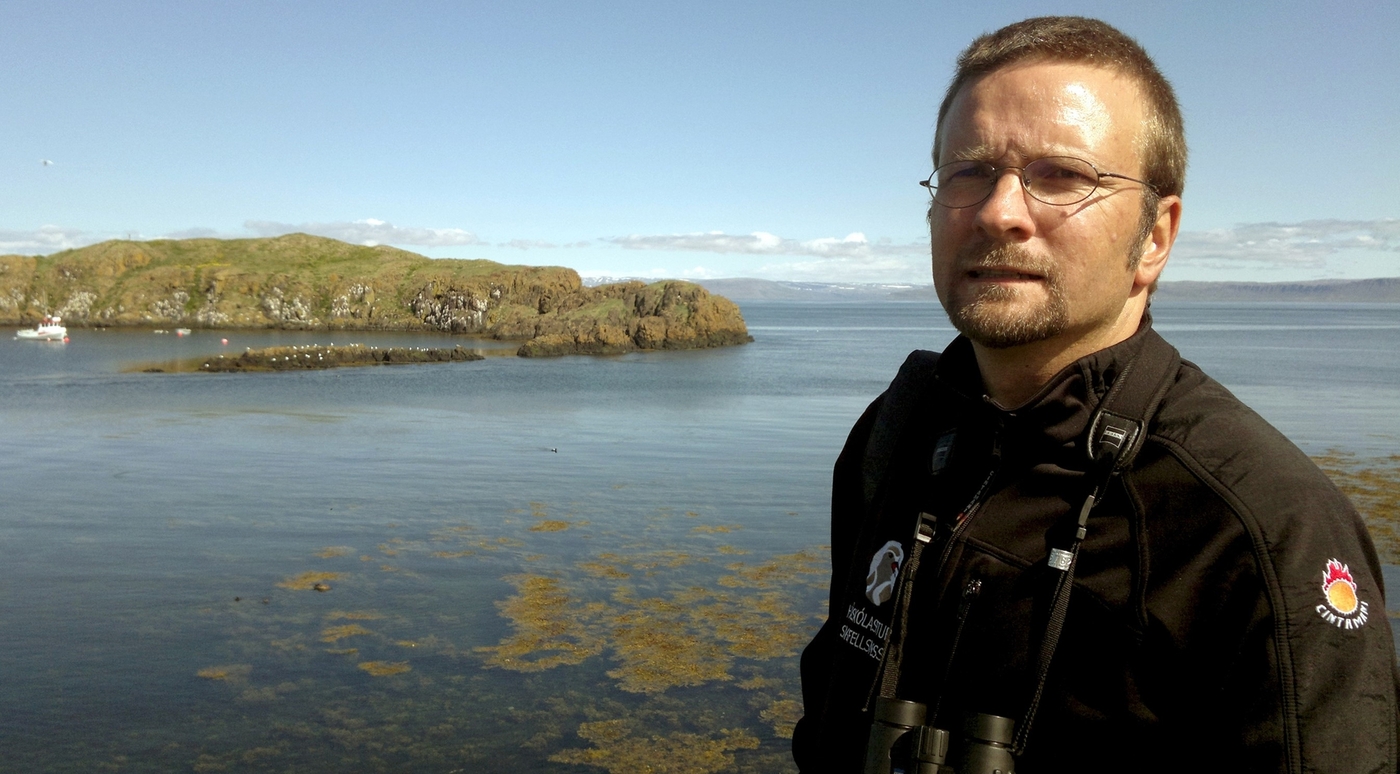"Anyone who wants to introduce an invasive species to Iceland should read this article to see for themselves what a terrible mistake it was to introduce mink. It was an absolute travesty that the warnings of the Chief Veterinary Officer, the ornithologist Finnur Guðmundsson, and many others were ignored."
So says Jón Einar Jónsson, research scientist and director of the UI Research Centre in Snæfellsnes. The article he refers to is a paper he recently published with his colleagues about changes to the ecosystems of islands in Breiðafjörður fjord after the arrival of the mink.
In particular, the team researched the breeding success of the common eider (Somateria mollissima), which has been an important species for Breiðafjörður farmers for centuries. The article was published in the respected journal Ecology Letters.
The research was based on data going back more than half a century. Long-term datasets spanning decades are invaluable for research into ecological changes, for example evaluating the impact of climate change, or in this case the impact of a predator on eider duck breeding success.
"We read very old newspaper interviews with the farmers in the area, who described the consequences they had observed. We also looked at diaries, people's memories of stories and dates, and other sources of information about how these changes occurred. It's a unique approach to build a study like this on these kinds of sources," says Jón Einar.
Some nesting grounds completely wiped out
The article describes changes to the eider nesting site in Brokey in Breiðafjörður, one of the best known nesting sites of the past 122 years. It documents the harmful impact of the arrival of the mink; the number of nests decreased significantly and there were also changes to the distribution of the birds that remained.
"We also looked at another nesting site on Purkey, just four kilometres north-west of Brokey, where the terrain is different. That example shows us how important it is for the birds to have refuge from predators. Predators find it hard to reach certain islands, like the southernmost islands of Purkey, due to the distance from the mainland and other islands and the tidal currents."
Jón Einar explains that the research also shows long-term changes, with populations on certain islands remaining strong and successful for a decade or two, but then being wiped out.
"There could be so many causes that we don't have data about, for example the link with the nesting success of gulls, which are predated by both Arctic foxes and mink. When the gulls disappear, the protection against ravens and eagles is also gone. Eider ducks will sometimes nest close to gulls, although they are also predators who will take both eggs and chicks. People here in Breiðafjörður have seen these things and have told us about them."
Jón Einar explains that Arctic foxes tend to be concentrated on the larger islands, so the classic adaptive response of the eider duck is to nest on smaller islands as far from the mainland as possible.
"But this is no barrier to the mink, which is an excellent swimmer."
There seems to be little defence against the mink, which is evident in the dramatic changes to the eider duck's breeding success.
Although the male does stay around the nesting site at first, he takes no part in raising the ducklings. Most males leave the nesting site sooner or later and gather in large flocks near the coast to moult. Although the males get on with one another reasonably well in the summer and autumn, this is not the case in the run up to the nesting season, when they are focused on defending their mates from rival males. There is often a fair amount of commotion to be seen as the males compete to determine who will breed with each female. Image/Daníel Bergmann.

One of the most abundant birds in Iceland
The eider duck is one of the most widespread species in Iceland and the most commonly sighted from the shore. It is by far the most abundant duck in Iceland with a population that probably totals almost one million in the autumn when the ducklings have fledged.
Jón Einar explains that eider ducks generally nest near the shoreline or on small hills on the islands and the latter provides the best defence against the mink, which generally keeps to the shoreline.
The female is brown and well camouflaged during nesting season, while the black and white male stands out. The female incubates the eggs alone and her inconspicuous plumage is essential for that task.
Although the male does stay around the nesting site at first, he takes no part in raising the ducklings. Most males leave the nesting site sooner or later and gather in large flocks near the coast to moult. Although the males get on with one another reasonably well in the summer and autumn, this is not the case in the run up to the nesting season, when they are focused on defending their mates from rival males. There is often a fair amount of commotion to be seen as the males compete to determine who will breed with each female.
Predators ignore conservation laws
The eider duck has been a protected species for almost two hundred years, due to the practical and economic value of eiderdown, which has been an important resource here in Iceland and in other countries for centuries.
"Farmers from Breiðafjörður collect the eiderdown, but they don't put up flags or other defences, since the nesting sites are spread over many different islands and not concentrated in a specific area as they are in many mainland locations in the West Fjords, North Iceland and the East Fjords. It's the same with the nesting sites at Rif on Snæfellsnes peninsula," explains Jón Einar.
The eider duck is in fact the only wild bird that benefits from living in close proximity with humans, since people often do what they can to protect the ducks from predators – mainly Arctic foxes and mink, as well as ravens, skuas, and various gulls and birds of prey. The white-tailed eagle was long considered a major predator and was probably targeted by an organisation founded to eradicate the enemies of the eider duck, often called the 'Vermin Society'. Fortunately for Icelandic biodiversity, the white-tailed eagle was not eradicated and the population has been recovering slowly over the last century. The white-tailed eagle was almost extinct in Iceland at the start of the 20th century due to the practice of laying poison for Arctic foxes, a practice that probably harmed many more species as well, such as ravens and various gulls.
The white-tailed eagle was not legally protected until 1914 when the situation had reached crisis point. Although the practice of harvesting eiderdown began in Iceland in the 17th century, the eider duck was not protected until 1847, the first bird in Iceland to have that status.
Jón Einar explains that the global eider duck population has fallen everywhere this century. This includes populations in the Nordic countries, Scotland and North America.
"We can see from the Brokey data that the cooler climate from 1900 to 1930 was the peak of breeding success for the eider duck population there in the 20th century. That's probably because the marine organisms on which it feeds are not as abundant when ocean temperatures rise."
The other authors of the paper are Árni Ásgeirsson, Florian Ruland, Fiona Rickowski and Jonathan Jeske. Árni is Jón Einar's colleague in Snæfellsnes, while the other three authors are based at the Freie Universität in Berlin.
The data on which the research is based was collected by the people of Brokey and Purkey and was made accessible on the initiative of Páll Hjaltalín, Bergur Hjaltalín and Ásta Ásmundsdóttir of Brokey and Jón Helgi Jónsson of Purkey. The team also used interviews and newspaper articles, as well as diaries and conversations, to create timelines detailing the presence of Arctic foxes and mink in Brokey and Purkey. According to Jón Einar, the team also used older research by Þorvaldur Björnsson and Páll Hersteinsson, the latter of whom is a professor at the University of Iceland.




